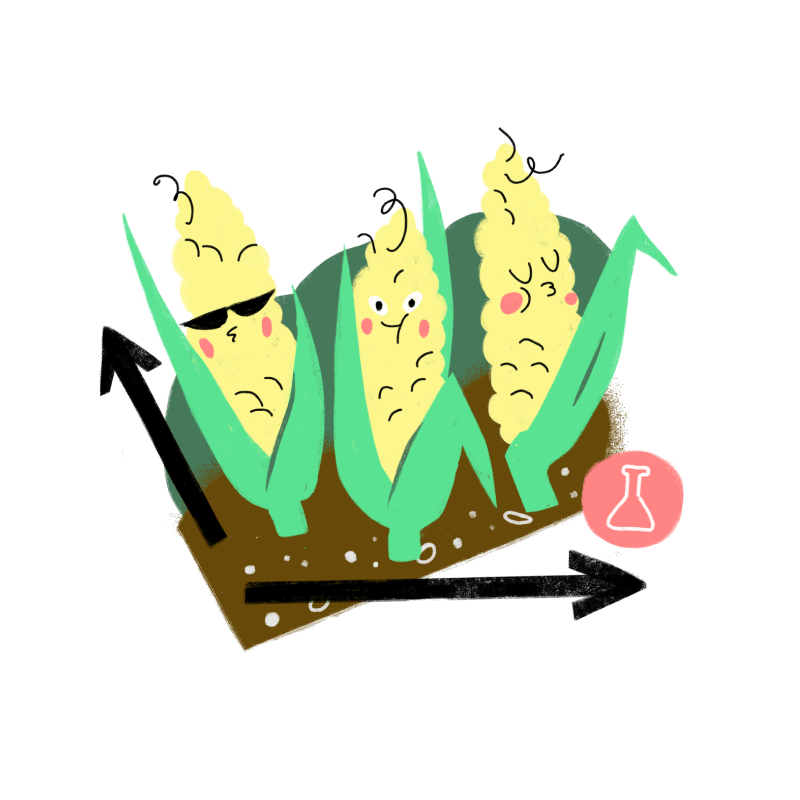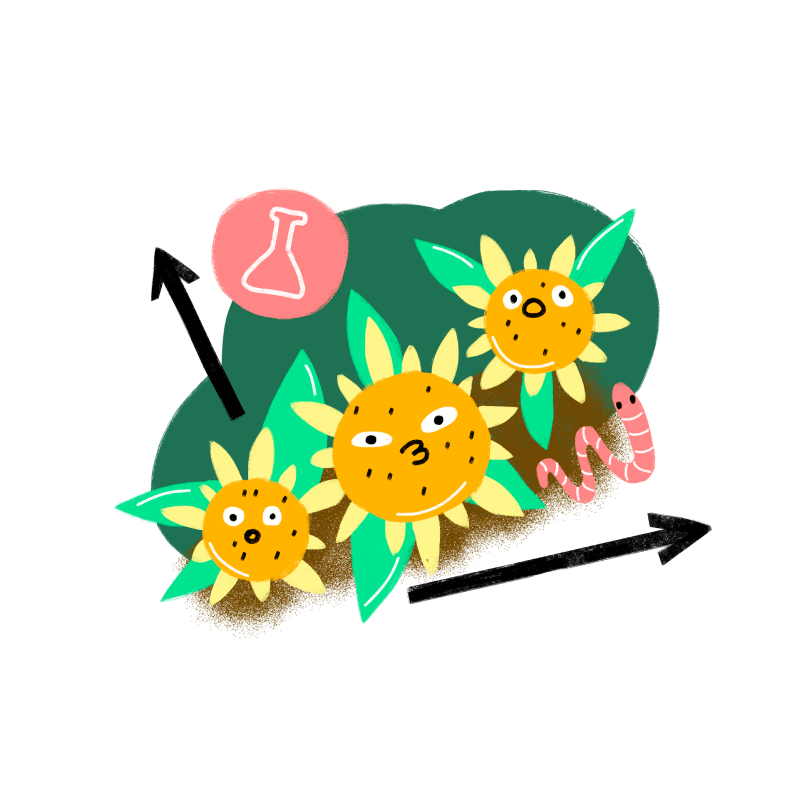
Does Sunflower Respond to an Increased Seeding Rate?
Estimated reading time — 15 minutes
Experiment in two neighboring sunflower fields
Experiment in two neighboring sunflower fields

Usevalad Henin
Usevalad is an expert in GIS and agricultural chemistry. He has been developing precision farming tools since 2013. He is also the co-founder of OneSoil.
All last year, I tested variable-rate seeding (VRS), the primary technology in smart farming. I experimented with seeding rates in fields with different climatic conditions and various limiting factors. I planted a great number of hybrids and compared their reaction to the variable seeding rate.
In this article, I'll continue to discuss the results of my experiments. This time, we'll talk about sunflowers in chernozem, a humus-rich dark soil. I previously wrote about how the crop reacts to variable-rate seeding in chestnut soil. You can find out whether I managed to increase crop yield this time around in the article's conclusions.
In this article, I'll continue to discuss the results of my experiments. This time, we'll talk about sunflowers in chernozem, a humus-rich dark soil. I previously wrote about how the crop reacts to variable-rate seeding in chestnut soil. You can find out whether I managed to increase crop yield this time around in the article's conclusions.
I conducted the experiment with Ivan Humenyuk, Director of Innovation at one of the farms in central Ukraine. The farm where Ivan works covers an area of approximately 6,000 hectares. Its main crops are sunflowers, corn, and wheat.
We laid out this experiment in two neighboring sunflower fields. Both have heterogeneous reliefs and yields.
We laid out this experiment in two neighboring sunflower fields. Both have heterogeneous reliefs and yields.
Throughout the experiments, the OneSoil team helped farmers analyze and plan fieldwork. The farmers selected the seeds and equipment.
Throughout the experiments, the OneSoil team helped farmers analyze and plan fieldwork. The farmers selected the seeds and equipment.
Hypotheses
Primary. I assumed that the high-productivity areas would provide nutrients to a larger number of plants. So I increased the planting rate in these areas and decreased it in low-productivity ones. I applied this logic to the whole field.
Alternative. I proposed this hypothesis counter to the primary one. I assumed that field plants would compete for sunlight rather than nutrients and moisture. As such, I lowered the seeding rate in high-productivity areas and increased it in low-productivity ones. To test the alternative hypothesis, I placed one test strip in the field.
Alternative. I proposed this hypothesis counter to the primary one. I assumed that field plants would compete for sunlight rather than nutrients and moisture. As such, I lowered the seeding rate in high-productivity areas and increased it in low-productivity ones. To test the alternative hypothesis, I placed one test strip in the field.
Experimental setup
1. Delimit productivity zones.
2. Identify the limiting factor.
3. Configure prescription maps for equipment.
4. Analyze yield maps.
2. Identify the limiting factor.
3. Configure prescription maps for equipment.
4. Analyze yield maps.
Experimental setup
1. Delimit productivity zones.
2. Identify the limiting factor.
3. Configure prescription maps for equipment.
4. Analyze yield maps.
2. Identify the limiting factor.
3. Configure prescription maps for equipment.
4. Analyze yield maps.
How the experiment went in Beta Field
For convenience's sake, let's call the first field Beta.
The field covered an area of 110 hectares. The field’s relief is not homogenous, featuring a 35-meter difference in elevation.
I delineated productivity zones using vegetation data for the past four years. Vegetation data in the primary phenological phases aligns with the field's yield and helps assess productivity.
Discover productivity zones of your field in the OneSoil web application.

I delimited productivity zones
Limiting factor. I analyzed the relief and compared it to the productivity map. It turned out that the productivity zones closely align with the slope map. In my experience, the bigger the slope, the higher the probability of soil erosion is in these areas. Erosion, therefore, leads to decreased soil fertility. It means that the relief in this field is limiting yield.

Slope map of Beta Field. The slope is over 3.5 degrees.
Before compiling the prescription map, I calculated seeding rates for sunflowers. There were three of them for high- and low-productivity zones, and two for the moderate-productivity zone. The seeding rate varied from 50,000 to 70,000 seeds per hectare. I increased the number of seeds in high-productivity zones and decreased it in low-productivity ones.
I also placed two test strips in the field. I did the first one with the reverse logic of seeding rate distribution to check the alternative hypothesis. I applied the standard seeding rate in the second one, i.e., 65,000 seeds per hectare.
I also placed two test strips in the field. I did the first one with the reverse logic of seeding rate distribution to check the alternative hypothesis. I applied the standard seeding rate in the second one, i.e., 65,000 seeds per hectare.
Create a prescription file for the onboard computer for free in the OneSoil web application

Prescription map for Beta Field
Yield map analysis. The harvest was gathered in August, then I exported the yield map from the combine harvester's onboard computer. It seems that yields didn't change in zones with different sunflower seed rate per hectare.

The yield map for Beta Field. Received from the onboard computer.
To make sure, I delimited homogenous plots in the field. These are areas with similar values for yield, productivity, and seeding rates at every point.
I delineated homogenous areas for Beta Field manually
Average yield in the homogenous plots in Beta Field
Analyzing the yield in these plots helps to make a more precise assessment of the experiment findings. I manually select noiseless data, compare the average yield in the delimited plots in each productivity zone, and put them in a spreadsheet.
Average sunflower yield per hectare, t/ha
The table shows that seeding rates didn't affect the yield, resulting in 4.15 t/ha with seeding rates of 50,000 and 70,000 seeds per hectare in the high-productivity zone. The sunflower yield neither increased nor decreased. It turns out that if I had known the results in advance, I wouldn't have spent a fortune on seeds.
How the experiment went in Lambda Field
Let’s name the second field as Lambda
I conducted the experiment in the same way in this field. The only difference is that, in Lambda Field, I looked at sunflower density to see the dependency between the number of plants in the blooming period and seeding rates.
Lambda Field covered an area of 111 hectares. The field’s relief isn’t homogenous due to its drainage hollows with a 15-meter difference in elevation.
Lambda Field covered an area of 111 hectares. The field’s relief isn’t homogenous due to its drainage hollows with a 15-meter difference in elevation.
Lambda Field’s productivity zones from the OneSoil web application
Slope map of Lambda Field
Similar to the first field, I analyzed Lambda’s productivity zones and relief. I compared them to understand what is limiting productivity in the field. In this case, the drainage hollows where water usually gathers, and the high slope affected the yield.
Creating a prescription map. I applied the same logic of seeding rate distribution to Lambda Field. I increased the seeding rate in high-productivity areas and decreased it in low-productivity ones. To check the alternative hypothesis, I placed a test strip using reverse logic. This is the prescription map for this field.

Prescription map for Lambda Field
Assessing the plant population in the blooming period. We first need to create an orthophoto to count the number of plants in each zone with different seeding rates. This is a photo of the field with a high spatial resolution (in our case, less than 1 cm). Using it makes it easy to manually count plants and find the precise number for each zone. Ivan made the orthophoto using a drone.

Ivan Humenyuk's orthophoto
I then manually counted how many sunflower heads there were. I had the data on the actual seeding rate for 10×10-meter plots, so I used these squares to count.

Here are the numbers I got for the high-productivity zone.
The average germination rate in the high-productivity area with a seeding rate of 70,000 per hectare was 78.3%, 79.1% for a seeding rate of 65,000 per hectare, and for a seeding rate of 50,000 per hectare, it was 84.5%.
What does it mean? It means I could save money on seeds. When increasing the seeding rates in high-productivity areas, I noticed a consistent trend of decreased plant density. There was a 6% difference in the germination rate between seeding rates of 50,000/ha and 70,000/ha.
I noticed the same tendency in moderate- and low-productivity areas. There was about a 5−6% difference in the germination rate with high and low seeding rates.
After the field was harvested, I analyzed the yield map and calculated average yield values.
What does it mean? It means I could save money on seeds. When increasing the seeding rates in high-productivity areas, I noticed a consistent trend of decreased plant density. There was a 6% difference in the germination rate between seeding rates of 50,000/ha and 70,000/ha.
I noticed the same tendency in moderate- and low-productivity areas. There was about a 5−6% difference in the germination rate with high and low seeding rates.
After the field was harvested, I analyzed the yield map and calculated average yield values.
The yield map for Lambda Field. Received from the onboard computer.
Average yield in the homogenous plots in Lambda Field
Average sunflower yield per hectare, t/ha
The conclusion for Lambda is the same as for Beta: the sunflower seeding rates didn't affect the yield.
VRS experiment results
I failed to increase yield. I drew three conclusions from the experiment.
The first is that the variable-rate seeding wasn’t needed in this case. The yield didn’t increase when the seeding rate was changed; on the contrary, the germination rate fell.
The second is that sunflowers are a very flexible crop that can adapt to variable-rate seeding. This year, I plan to continue conducting experiments in sunflower fields to gather enough data to confirm this hypothesis.
The first is that the variable-rate seeding wasn’t needed in this case. The yield didn’t increase when the seeding rate was changed; on the contrary, the germination rate fell.
The second is that sunflowers are a very flexible crop that can adapt to variable-rate seeding. This year, I plan to continue conducting experiments in sunflower fields to gather enough data to confirm this hypothesis.
The third conclusion is that this farm can lower the standard sunflower seeding rate since I got roughly similar harvest yields using different seeding rates. This underlines the necessity to carefully choose seeding rates to avoid wasting money.
Fill out our application to take part in our experiments.
“
"We've been experimenting with OneSoil for some time now. We usually work by having the team lay out experiments according to my preferences, in places where I'd like to check something based on my knowledge about the field's set-up. I'm pretty happy with the results and partnership overall and with this experiment specifically. I'm thinking about optimizing the number of seeds I'll use next season."
Experiment conducted by Usevalad Henin
Illustrations created by Nastia Zenovich and Dasha Sazanovich
Text edited by Tanya Kavalchuk
Article layout by Anton Sidorov
Illustrations created by Nastia Zenovich and Dasha Sazanovich
Text edited by Tanya Kavalchuk
Article layout by Anton Sidorov
Want to
conduct an experiment
with OneSoil?
conduct an experiment
with OneSoil?


Try OneSoil Yield now
Any farmer can purchase the program from an agricultural technology dealer in his region. Explore the app's features in a free demo account to take care of any doubts you may have before buying it.
Related Articles
People, fields and technology
Get all new articles straight to your inbox! You can read them even in the field.




